The Sad History of the Parthenon Marbles
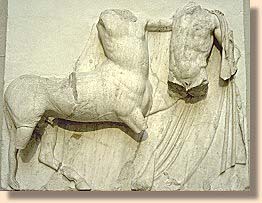 One of the greatest artistic achievements ever is the Parthenon. Many
sculptures were removed from the temple and transported to England. The
famous "Elgin Marbles" are in London now. But there is a big question:
where should these marbles be? Here, we tell the story of the Parthenon
Marbles, based on the pamphlet "The Parthenon and the Elgin Marbles" by
Epaminondas Vranopoulos , published by the Society for Euboian Studies
in 1985. We would like to thank Mr Vranopoulos for granting us
permission to reproduce extracts from his pamphlet.
One of the greatest artistic achievements ever is the Parthenon. Many
sculptures were removed from the temple and transported to England. The
famous "Elgin Marbles" are in London now. But there is a big question:
where should these marbles be? Here, we tell the story of the Parthenon
Marbles, based on the pamphlet "The Parthenon and the Elgin Marbles" by
Epaminondas Vranopoulos , published by the Society for Euboian Studies
in 1985. We would like to thank Mr Vranopoulos for granting us
permission to reproduce extracts from his pamphlet.
You can download the complete pamphlet "The Parthenon and the Elgin
Marbles" by Epaminondas Vranopoulos. This is still a copyright work but
you will not be charged for downloading the pamphlet.
Plain text .zip file (size 25 kb):
pamphlet1.zip
containing the file vran.txt.
HTML .zip file (size 25kb):
pamphlet2.zip
containing the file vran1.htm.
Part One: The Construction of Parthenon
"The Greeks were gods!" - Henry Fuseli, Swiss painter, on seeing the Marbles.
After their victory against the Persians at Plataea in 479BC the Athenians returned to their abandoned city and found all the buildings on the Acropolis had been laid waste.
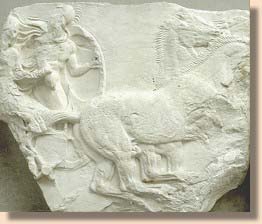 Pericles wanted to rebuild the city and make it an artistic and cultural
as well as political hellenic centre. During the thirty years of
Pericles' rule, many buildings were erected like the Parthenon, the
Propylaea and many others.
Pericles wanted to rebuild the city and make it an artistic and cultural
as well as political hellenic centre. During the thirty years of
Pericles' rule, many buildings were erected like the Parthenon, the
Propylaea and many others.
The general artistic supervision of the Acropolis buildings was assigned
to Pheidias who distinguished himself by producing decorations that were
unique in magnificence.
In 439BC the Parthenon was dedicated to the goddess Athena and it took
15 years to complete. This is a remarkably short time when one considers
the principles of architecture employed, some of which are still unknown
to us.
In 450AD the Parthenon was turned into a Christian church dedicated to
the Virgin Mary, but in 1204, when the Franks occupied Athens they
turned the Parthenon into a Catholic church and when the Turks arrived
in 1458 the Parthenon became a mosque with Turkish houses built around
it.
In 1674, the French ambassador, the Marquis de Nointel, paid a visit to
Athens accompanied by Jacques Carrey who made drawings of the Parthenon.
Carrey's drawings show that at that time the Parthenon still remained
intact.
Thirteen years later, in 1687, the Venetian general Francesco Morosini
laid siege to the Acropolis. He bombarded the Acropolis, even though he
knew that the Turks were storing gunpowder there. The result was an
explosion which destroyed much of the Parthenon.
Part two: The Stripping of the Parthenon
"Lord Elgin may now boast of having ruined Athens." - Anonymous Greek, 1810.
Thomas Bruce, seventh earl of Elgin, was the British ambassador at
Constantinople in 1799 and he wanted to be of service to the Arts by
making his countrymen more familiar with Greek antiquities. He put
together a team of painters, architects and moulders.
The following year, the local Turkish commandant allowed the artists to
make drawings but refused to allow them to take casts or build
scaffolding for a closer look at the sculptures.
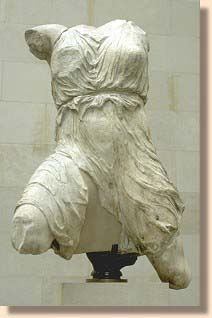 In 1801 Elgin obtained a firman , or authority, from the Sultan which
gave him permission to take away any sculptures or inscriptions which
did not interfere with the works or walls of the citadel.
In 1801 Elgin obtained a firman , or authority, from the Sultan which
gave him permission to take away any sculptures or inscriptions which
did not interfere with the works or walls of the citadel.
The looting of the Parthenon began immediately. The sculptures were
lowered from the temple and transported by British sailors on a gun
carriage. On December 26 1801, fearing the French might try to obstruct
his work, Elgin ordered the immediate shipment of the sculptures on the
ship "Mentor" which he had brought for this purpose.
During 1806, one of the Caryatids was removed, as well as a corner of
the Erechtheum, part of the frieze of the Parthenon, many inscriptions
and hundreds of vases.
Others joined in the looting and this incredible activity, which was not
confined to the Acropolis but was carried out throughout Athens and
large parts of Greece, continued for many years. In 1810 Elgin loaded
the last of his booty on the warship "Hydra".
In 1817 two more warships, the "Tagus" and the "Satellite", were loaded
with gravestones, copperware and hundreds of vases. Four years later,
the Greek War of Independence finally brought Elgin's looting to an end.
Part Three: The Elgin Marbles in London
"Quod non fecerunt Gothi, hoc fecerunt Scoti" "What the Goths did not do, the Scots did here" - Graffiti, Athens 1813
It was January 1804 when the first 65 cases arrived in London, where they remained for two years because Elgin had been imprisoned in France.
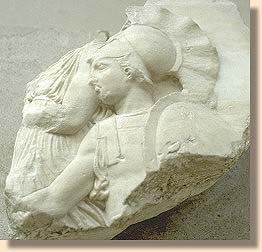 The maltreatment which the Marbles suffered was unavoidable. They were
placed in the dirty and damp shed and grounds of Elgin's Park Lane house
and remained there for years, decaying in London's damp climate, while
he tried to find a buyer.
The maltreatment which the Marbles suffered was unavoidable. They were
placed in the dirty and damp shed and grounds of Elgin's Park Lane house
and remained there for years, decaying in London's damp climate, while
he tried to find a buyer.
Elgin made attempts to sell the Marbles to the British government but
the price he asked was so high that they refused to buy them. As the
years passed, so the Marbles influenced the lives of people in Britain.
Churches, buildings and houses were built in Greek classical style.
In a letter written by Elgin in 1815, he admitted that the Marbles were
still in the coal shed at Burlington House, decaying from the
destructive dampness.
Finally, in 1816, the Marbles were sold to the British government and
were at once transferred from Burlington House to the British Museum,
where a special gallery was eventually built for them by Sir Joseph
Duveen at his own expense.
In December 1940 a Labour MP, Mrs Keir, asked the Prime Minister,
Winston Churchill whether the Marbles would be returned to Greece in
partial recognition of that country's valiant resistance to the Germans
and the sacrifices of its people. The answer was negative. At the time
that Mrs Keir tabled her question, there was a large number of letters
published in the Times favouring the return of the Marbles to Greece.
In 1941 the head of the Labour Party, Clement Attlee, who was a member
of the wartime coalition government, replied to Mrs Keir's question,
saying that there was no intention to take any legal steps for the
return of the Marbles.
Part Four: Contemporary comments on Lord Elgin's looting
"He (Elgin) looted what Turks and other barbarians considered sacred." - J. Newport MP
Edward Clarke, in his book "Travel to European Countries", published in 1811, wrote one of the most famous descriptions of the actual operations on the Acropolis by Lord Elgin's workteam under the supervision of Lusieri. According to Clarke, who witnessed the removal of the metopes, it was a fantastic and marvellous sculpture. But tragedy struck when a part of the Pentelic marble collapsed under the pressure of Elgin's machines and Clarke states that even the Turkish commander cried as the marble was smashed to pieces.
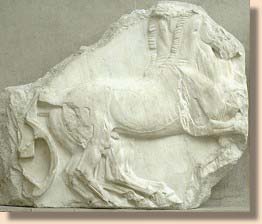 Clarke also makes the point that Elgin's workteam didn't ruin the
Parthenon by mistake, but they also cut the marble into smaller pieces
for easier transport.
Clarke also makes the point that Elgin's workteam didn't ruin the
Parthenon by mistake, but they also cut the marble into smaller pieces
for easier transport.
He was also aware that Pheidias and his fellow-sculptors had designed
the decorations to the Parthenon in such a way that they could be seen
at their best from below, not at eye level in a museum.
He concludes by saying that the shape of the temple suffered damage
greater than that suffered by Morosini's artillery, that a great
iniquity had been committed and that the English government could have
demanded that the Turkish government took measures to protect the
sculptures.
Edward Dodwell states in refutation of the British argument that the
Greeks weren't indifferent to the preservation of the monuments. Many
had complained about the ruination to the Sultan because he had given
permission to Elgin to make his plans. He also says that he felt
humiliation at being present at the looting of the most exquisite
sculptures and architectural members. He adds that the arts in England
could have benefited from castings of Pheidias' sculpures and ends by
saying that not only was sacrilege committed but also the work had been
assigned to people who only cared for their individual interests.
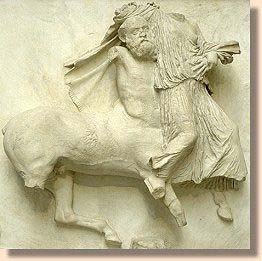 Thomas Hughes, an English clergyman, gives a shocking picture of the
plunder of the Acropolis: "Tympana capitals, entablature and crown, all
were lying in huge heaps that could give material for the erection of an
entire marble palace."
Thomas Hughes, an English clergyman, gives a shocking picture of the
plunder of the Acropolis: "Tympana capitals, entablature and crown, all
were lying in huge heaps that could give material for the erection of an
entire marble palace."
The English painter Hugh Williams admitted that the Elgin Marbles would
certainly have contributed to the progress of the arts in England but he
didn't accept the right to uproot them from Greece.
Lord Broughton also mentions the damage to the Parthenon and accuses
Elgin of having planned to remove the entire temple of Theseum
(Hephaestus).
Francis Douglas, a British MP, assured Parliament that the Greeks
admired the remnants of the Parthenon and that even the Turks had begun
to appreciate their value. He also said that every sculpture of the
Parthenon reminds us of the chisel of its creator and those for whom it
was created. He ended by expressing his great disappointment at the
impudence of the hands that were not afraid to dislocate the magnificent
objects of the Parthenon and he praised Chateaubriand, who had charged
Elgin with sacrilege.
Part Five: British views on the return of the Marbles
"The marble caused us a lot of difficulties and I had slightly to become a barbarian." - Lusieri to Elgin
Elgin's second attempt to sell the Marbles to the British government led
to a debate in Parliament where Sir John Newport MP said about Lord
Elgin: "The Honourable Lord has taken advantage of the most
unjustifiable means (i.e. bribery) and has committed the most flagrant
pillages. "
On the same day, the speaker of Parliament noted in the calendar: "Lord
Elgin's petition has been filed. His ownership rights on the collection
have been contested; his conduct has also been censured."
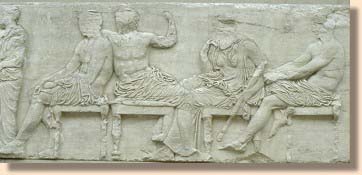
Among the first people to criticise Lord Elgin was H. Hammersley MP. He
advocated that if any future Greek government demanded the Marbles back,
England should return them without any further procedure or negotiation.
Dodwell and Clarke suggested at least the return of the Erectheum
cornice and the Ionic column.
Also in 1890 an editorial by Franklin Harrison, which appeared in the
magazine "19th Century", entitled "Return the Elgin Marbles!" maintained
that the sculptures were more dear to the Greeks than to the British.
Besides that, Philip Sassoon MP, and Private Secretary to the Prime
Minister at the time, wrote in the Times in 1928 that the splendid ruins
of the Parthenon and the bright air of Athens would be a more suitable
place for the most harmonious sculptures in the world, than the British
Museum.